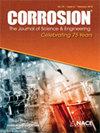Atmospheric Corrosion of Steel Infrastructure in Canada under Climate Change
IF 1.1
4区 材料科学
Q4 MATERIALS SCIENCE, MULTIDISCIPLINARY
引用次数: 0
Abstract
Protection against atmospheric corrosion of steel infrastructure and its components requires assessment and prediction of corrosion rates using quantitative and reliable modelling of the environmental parameters that impact the corrosion process. This has become even more critical in the context of climate change. This study demonstrates the feasibility of using ISO Dose-response Functions (DRFs) to classify atmospheric corrosivity in Canada to improve the current qualitative approach to the corrosion design of carbon steel infrastructure, especially bridges. The DRF predictions for first-year corrosion rates were first confirmed using a set of historical field data collected from different locations across Canada. Further examination has revealed a dramatic change in atmospheric corrosivity at many locations in Canada since the last systematic effort in field data collection in the 1950-60s. it is believed that this was caused by significant drop in in sulfur dioxide levels in the atmosphere. A projection of future corrosivity in various Canadian cities with differing climates was also presented by considering the projected impacts of climate change on the temperature and relative humidity. This study has shown a promising precursor for the development of a corrosivity map in Canada to better guide the corrosion design and protection of steel infrastructure. Furthermore, this study has demonstrated an acute need to understand the current chloride deposition conditions of steel bridges, including the increased local exposure of roadways to corrosivity by the use of de-icing salts.气候变化下加拿大钢铁基础设施大气腐蚀研究
为了防止钢铁基础设施及其部件的大气腐蚀,需要使用影响腐蚀过程的环境参数的定量和可靠建模来评估和预测腐蚀速率。在气候变化的背景下,这一点变得更加重要。本研究证明了在加拿大使用ISO剂量响应函数(DRFs)对大气腐蚀性进行分类的可行性,以改进目前碳钢基础设施(特别是桥梁)腐蚀设计的定性方法。DRF对第一年腐蚀速率的预测首先是通过从加拿大不同地点收集的一组历史现场数据来证实的。进一步的检查显示,自1950-60年代最后一次系统地收集现场数据以来,加拿大许多地点的大气腐蚀性发生了巨大变化。据信,这是由于大气中二氧化硫含量的显著下降造成的。通过考虑气候变化对温度和相对湿度的预估影响,还提出了不同气候条件下加拿大各城市未来腐蚀性的预估。这项研究为加拿大腐蚀性地图的开发提供了一个有希望的先驱,以更好地指导钢铁基础设施的腐蚀设计和保护。此外,这项研究表明,迫切需要了解当前钢桥的氯化物沉积条件,包括使用除冰盐增加的局部道路暴露于腐蚀性。
本文章由计算机程序翻译,如有差异,请以英文原文为准。
求助全文
约1分钟内获得全文
求助全文
来源期刊

Corrosion
MATERIALS SCIENCE, MULTIDISCIPLINARY-METALLURGY & METALLURGICAL ENGINEERING
CiteScore
2.80
自引率
12.50%
发文量
97
审稿时长
3 months
期刊介绍:
CORROSION is the premier research journal featuring peer-reviewed technical articles from the world’s top researchers and provides a permanent record of progress in the science and technology of corrosion prevention and control. The scope of the journal includes the latest developments in areas of corrosion metallurgy, mechanisms, predictors, cracking (sulfide stress, stress corrosion, hydrogen-induced), passivation, and CO2 corrosion.
70+ years and over 7,100 peer-reviewed articles with advances in corrosion science and engineering have been published in CORROSION. The journal publishes seven article types – original articles, invited critical reviews, technical notes, corrosion communications fast-tracked for rapid publication, special research topic issues, research letters of yearly annual conference student poster sessions, and scientific investigations of field corrosion processes. CORROSION, the Journal of Science and Engineering, serves as an important communication platform for academics, researchers, technical libraries, and universities.
Articles considered for CORROSION should have significant permanent value and should accomplish at least one of the following objectives:
• Contribute awareness of corrosion phenomena,
• Advance understanding of fundamental process, and/or
• Further the knowledge of techniques and practices used to reduce corrosion.
 求助内容:
求助内容: 应助结果提醒方式:
应助结果提醒方式:


